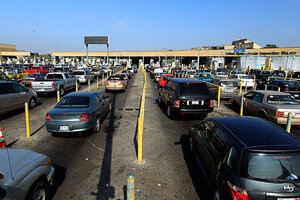What deters illegal immigrant border crossings into the US? Violence in Mexico.
The number of illegal immigrants apprehended while crossing Mexico en route to the US has dropped by almost 70 percent in the past five years, according to Mexican official data.

Motorists wait in lanes of traffic heading into the United States from Mexico at the US border crossing in San Ysidro, California on September 27. The number of Central American migrants apprehended while crossing Mexico en route to the US has dropped by almost 70 percent in the last five years, according to reports.
Mike Blake/Reuters
The perfect deterrent for illegal border crossings into the US? Violence in Mexico.
The number of Central American migrants apprehended while crossing Mexico en route to the US has dropped by almost 70 percent in the last five years, reports the Associated Press.
The estimate, provided by Mexico’s immigration commissioner Salvador Beltran del Rio, is based on apprehensions, which plummeted from 433,000 Central Americans in detention in 2005 to 140,000 last year.
While immigrant rights advocates argue that border fences, ever higher and more technologically advanced, do not deter illegal immigration – they just make it more dangerous – it does appear that the threat of kidnappings, forced recruitment, and mass murder at the hands of drug traffickers is keeping migrants home.
Not that the journey has ever been particularly pleasant – Central Americans have long dodged criminals and corrupt officials, and taken their chances jumping on and off Mexican cargo trains headed north. (See this story here from Mexico's southern border, or, for a more uplifting one, this tale of an amazing woman who cares for injured migrants.)
But now the scenarios are grimmer. The most chilling example of dangers faced: the 72 migrants, mostly Central American, found dead on a ranch in northern Tamaulipas in August last year.
Mexicans are also being dissuaded from traveling through northern Mexico, where some of the nation’s worst violence is playing out. You only have to read the story about Veronica Coronilla’s husband, who has gone missing since he left their home in March to find a job in construction in Houston, to understand why many would opt to stay home – even with no jobs.
National statistics show that migration from Mexico has fallen. Those figures jibe with US Customs and Border Protection data showing the number of those arrested trying to cross the US-Mexico border is down sharply.
The Monitor asked upon the release of those US figures whether violence was having a sizable impact on keeping Mexicans and Central Americans – and others – home.
The anecdotal evidence remains strong. Ms. Coronilla said that no one in her town is considering the journey. Instead they will stay home, depend on remittances from those relatives already in the US, and try to get day work on nearby farms.
But violence is not the only factor contributing to downward migration trends. There is slower population growth in Mexico and more border patrol presence on the US-Mexico border. And a well-known migration expert in Mexico, Rodolfo Casillas, brought up a good point upon the release of the newest figures from Mexico about drawing conclusions about migration trends using data like apprehensions.
He said to the AP: "What's dropping is the number of people being detained by immigration agents, which is different from the Central American migration flow that goes through Mexico.”
